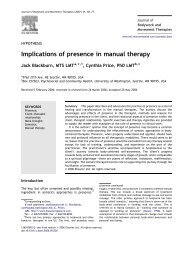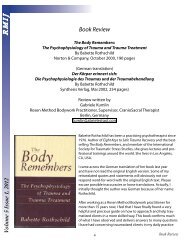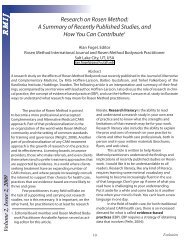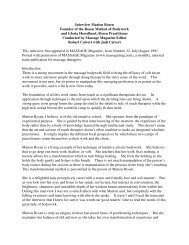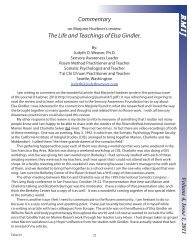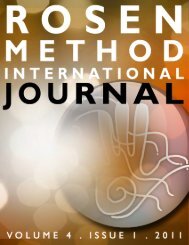download - Rosen Journal
download - Rosen Journal
download - Rosen Journal
You also want an ePaper? Increase the reach of your titles
YUMPU automatically turns print PDFs into web optimized ePapers that Google loves.
over the years. I highly recommend Rothschild’s book to other <strong>Rosen</strong> practitioners, teachers, students or any<br />
others who work in the body-mind field. Although I am not a trauma therapist, I often encounter mildly or<br />
severely traumatized clients in my <strong>Rosen</strong> practice. This book is a valuable resource, not only for us practitioners<br />
but also for anyone interested in trauma recovery.<br />
Rothschild transmits to us in simple, easily comprehensible terms and language the newest results of neurobiological<br />
and neuroscientific research and relates how to convincingly carry them into practice. She<br />
explains in a simple manner the significance and relevance of the limbic system (our “survival center”), the<br />
purpose and function of the amygdala and hippocampus, the complexity of engraved traumatizing events,<br />
their processing possibilities as well as their psychosomatic effects and distinctive features. She gives valuable<br />
advice on how to build a confident, safe and responsible relationship with our clients, from the mildly<br />
to the severely traumatized.<br />
<strong>Rosen</strong> Method bodyworkers obviously have learned how to offer safe and confident surroundings. In this<br />
book, however, we get additional information about dissociations and flashbacks, how to avoid wrong<br />
tracks, how to separate past from present, and why to work initially with the after-effects of trauma. This<br />
confirms what we do in <strong>Rosen</strong> sessions. We have learned how to avoid “falling” into the past. Dissociations or<br />
flashbacks do easily happen and I find steering narration and verbal empathy to the NOW and PRESENT can<br />
prevent wrong tracks. Certainly we do not wish to DO much with our hands but keep them clear and quiet,<br />
at one place, simply supporting the person.<br />
We enter the tricky and complex network of the nervous system, the ANS (autonomic nervous system) and<br />
SomNS (somatic nervous system) in order to better understand how traumatized clients regain a feeling of<br />
embodiment, felt sense, body awareness and body sensations. Rothschild offers us a huge range of options<br />
with which we can enhance and increase body awareness. She extensively explains the somatic resources<br />
that interfere with a person’s psychology and illustrates to the practitioner how to connect with them and<br />
how to offer more resources, anchors, and bonding options through touch and substantiated verbal empathy.<br />
For both clinicians and their clients, there is tremendous value in understanding the psychophysiology of<br />
trauma and knowing how to deal with its manifestations. This book illuminates that physiology, shining<br />
a bright light on the impact of trauma on the body and the phenomenon of somatic memory. Research<br />
has shown that people who have been traumatized hold an implicit memory of traumatic events in their<br />
brains and bodies. That memory is often expressed in the symptomatology of posttraumatic stress disorder<br />
—nightmares, flashbacks, startle responses, and dissociative behaviors. In essence, the body of the traumatized<br />
individual refuses to be ignored.<br />
While reducing the chasm between scientific theory and clinical practice and bridging the gap between talk<br />
therapy and body therapy, Rothschild presents principles and non-touch techniques for giving the body<br />
its due. The somatic techniques are chosen with a view to making trauma therapy safer while increasing<br />
mind-body integration. Reading her case studies at the end of the book made me reflect more on my daily<br />
bodywork sessions and certainly inspired me and upgraded my skills with traumatized clients. As a result, I<br />
address my questions to the client in a more precise way, while at the same time keeping a clear distance. I<br />
choose anchors together with the client and affirm resources in the present, making her feel safe, accepted<br />
and seen. Also my touch has changed. I hold a person in one place only, staying there rather than touching<br />
at different places and keeping my hands relatively quiet. I make sure she feels absolutely safe, very often<br />
not even lifting the sheet.<br />
Kumlin<br />
5<br />
R M I J Volume 5, Issue 1, 2012



